written by: Sarah Smith
 YES, you can do it, and yes, THEY CAN DO IT! Remember, these children just recently learned English without any formal instruction, and that same powerful mind is waiting to tackle something else. Youth is a ripe time for absorbing new information, and we decided to capitalize on it by starting our children into biblical Hebrew young, about age 6 or 7. Initially, I scoffed at the widespread advice that some knowledge of formal English grammar was essential to learning another language. “We don’t need to do that first—that’s not how they learn their mother tongue.” So we dove into Hebrew…..and slogged through lessons for two years before we got to any real translating. I kept having to stop and teach what “blank” (insert your favorite part of speech) was before I could teach about the Hebrew “blank” and how it was like the English “blank”…..oh, but also a little different, (you see the problem?). I eventually saw the problem, and have repented my earlier scoffing. So, do I wait and start the children when they are a little older? NO. We just go a little slower, and it looks something like this:
YES, you can do it, and yes, THEY CAN DO IT! Remember, these children just recently learned English without any formal instruction, and that same powerful mind is waiting to tackle something else. Youth is a ripe time for absorbing new information, and we decided to capitalize on it by starting our children into biblical Hebrew young, about age 6 or 7. Initially, I scoffed at the widespread advice that some knowledge of formal English grammar was essential to learning another language. “We don’t need to do that first—that’s not how they learn their mother tongue.” So we dove into Hebrew…..and slogged through lessons for two years before we got to any real translating. I kept having to stop and teach what “blank” (insert your favorite part of speech) was before I could teach about the Hebrew “blank” and how it was like the English “blank”…..oh, but also a little different, (you see the problem?). I eventually saw the problem, and have repented my earlier scoffing. So, do I wait and start the children when they are a little older? NO. We just go a little slower, and it looks something like this:
- Work through a Hebrew Primer to learn the Aleph Bet, (age 7ish. When they are showing good progress with reading and writing English).
- After graduating from the Primer, continue to pursue language acquisition, (a.k.a. Hebrew vocab. Ideas and recommendations here) and dailyish Hebrew copywork from a Hebrew Bible or a copywork book. Meanwhile, [insert sheepish chuckle] the child is going through a year of formal instruction in English grammar. I highly recommend Junior Analytical Grammar by R. Robin Finley.)
- Then, two years from the start of their Hebrew journey, they begin a Hebrew grammar, (which subject is worthy of its own page, and I encourage you to peruse all the information we have gathered).
Below is a talk by Rabbi Jonathan Rietti that encapsulates my Hebrew-learning mentality for our children. Warning: He speaks quickly and does use a lot of Hebrew words, but hang in there. It is not that long of a talk, and is well worth the listening effort.
Step number one is learning the Hebrew letters, and before I started teaching our first four children, I searched everywhere for a Primer and could not find what I wanted. So I wrote one, (famous last words, “This shouldn’t be too involved”).
You can purchase a physical copy by clicking the blue button below, or visit our Shop and save some money on a digital version.

If you want to know why I had to re-invent the wheel, you can read the Preface and see if you agree. You may also take a Peek Inside the student workbook.
Our Hebrew Aleph Bet curriculum is two volumes: a workbook and teacher’s manual, so make sure you get both if you decide to order.
helpful hints for teaching hebrew
After two false starts with teaching Hebrew to our children, I acquired a mentality that made all the difference in our progress. Having a long-term vision for our Hebrew acquisition helps me with everything from planning lessons to keeping my patience when my students do not grasp a concept as quickly as I think they should. If we are going to be studying Hebrew our whole lives, it is easier to be content with incremental progress. I have found the most important thing is…three things:

Consistency:
Do a little bit every day,
(of course “every”
doesn’t count sickness,
a new baby, or “I-can’t-
stand-the-mess-
another-minute”).

Drill: Vocabulary
AND Concepts,
(how to drill concepts
is explained below).

Add something new
every other day or so,
to keep it fresh
and interesting.
drilling language concepts
To cement Hebrew grammar rules in our minds, I have adopted a system that I highly recommend. As the children learn something new, I make a 3×5 card for the new rule or concept in a question/answer format. For example:
Front of the card: What kind of syllables does Hebrew have?
Back of the card (which the children should respond with): Open and closed. Open syllables are “Consonant, vowel” and closed syllables are “C-V-C”.
We have a concepts box with all our cards, and drill those just as we would vocabulary. This has made ALL THE DIFFERENCE in the children’s progress. Prior to this, they might understand individual rules, and do fine for a few weeks, but when it came time to combine several concepts, (either in translation or learning another rule) it all went to pieces. Drilling the concepts embeds them in the children’s minds and enables quicker recall—and MUCH LESS FRUSTRATION, (on everyone’s part). I have read about “Language Notebooks” to achieve the same idea, but I find the box/card method simple and very effective, and more conducive to drilling.